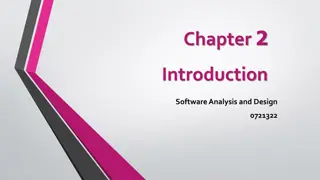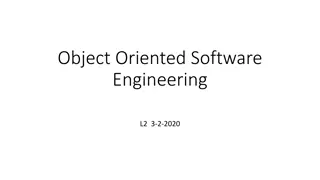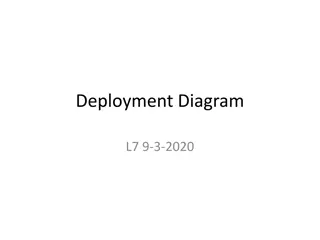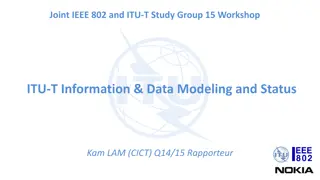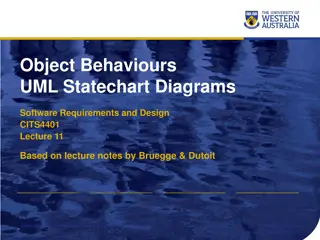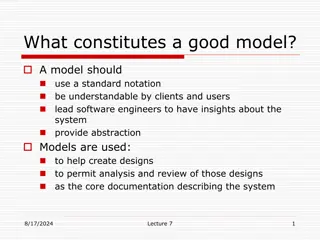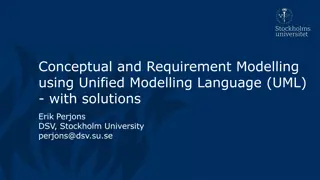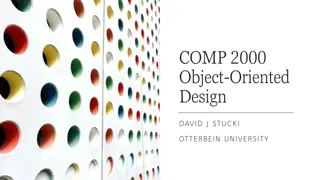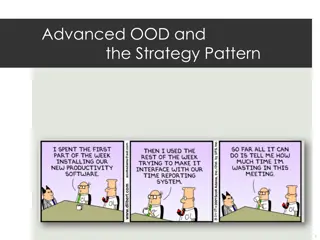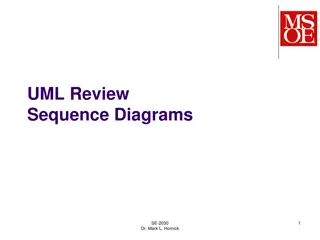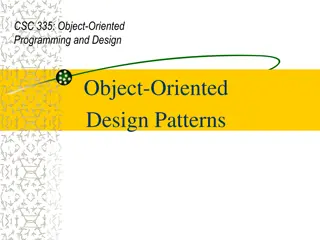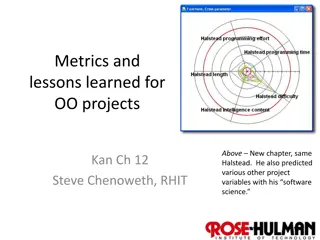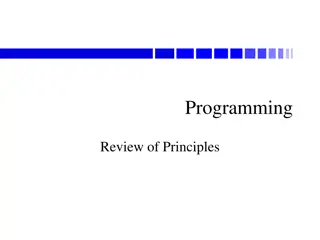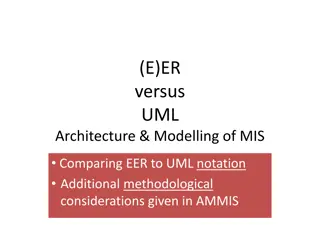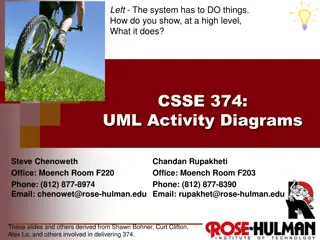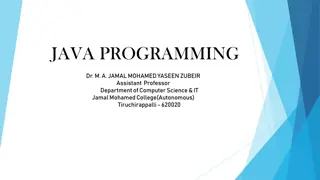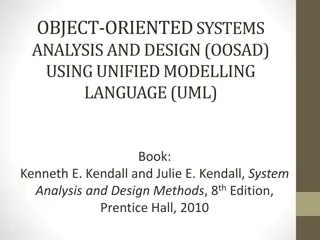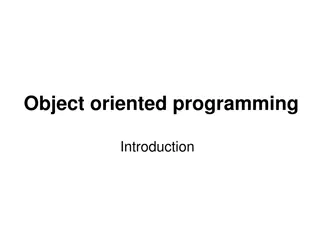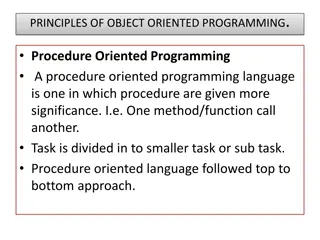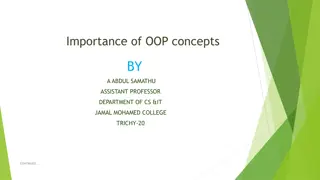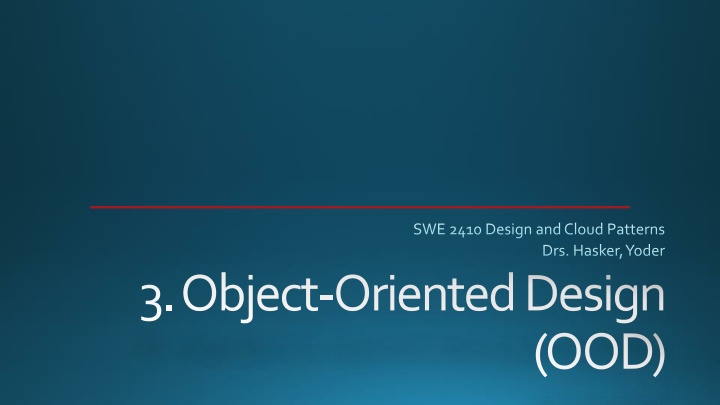
Object-Oriented Design and UML Refresher
This content provides insights into Object-Oriented Design (OOD) and UML concepts, focusing on Class Diagrams, Associations, Generalization, and Implementations. It discusses the meanings and visual representation of "is-a," "has-a," and "needs-a" relationships, emphasizing minimal clutter in diagrams for enhanced understanding. The importance of connectors, role names, and directions in class diagrams is highlighted, with practical examples given to illustrate these concepts.
Download Presentation

Please find below an Image/Link to download the presentation.
The content on the website is provided AS IS for your information and personal use only. It may not be sold, licensed, or shared on other websites without obtaining consent from the author. If you encounter any issues during the download, it is possible that the publisher has removed the file from their server.
You are allowed to download the files provided on this website for personal or commercial use, subject to the condition that they are used lawfully. All files are the property of their respective owners.
The content on the website is provided AS IS for your information and personal use only. It may not be sold, licensed, or shared on other websites without obtaining consent from the author.
E N D
Presentation Transcript
SWE 2410 Design and Cloud Patterns Drs. Hasker, Yoder 3. Object-Oriented Design (OOD)
UML Refresher See https://faculty-web.msoe.edu/hasker/swe2410/samples/uml- sample Basic notation to know: Class, attributes, methods No constants, other trivial attributes; types only where critical No constructors, setters, getters Associations: directed, undirected Show just the association if another class is a member Directed association: has-a; more on this later Multiplicities: *, +, 1, 3..5 Role names: names for class instance variables Generalization, implements Stereotypes: <<interface>>, <<abstract>>, etc.
is-a, has-a, needs-a What does is-a mean in a class diagram? How is this drawn? What does has-a mean in a class diagram? What are the different ways this can be drawn? Note: if has-a is in the domain, don t want to introduce programming concepts like declarations! Don t show both an association and attribute for the same concept! Special case for has-a : needs-a The train car needs wheels or it s not really a train car! Always use the arrow with this connector! Use is-a, has-a, needs-a to determine connectors Note the direction works in all cases At the domain level, these are invaluable checks Not reasonable: A box is a train car use BoxCar instead Caution: don t use needs-a everywhere Yes, requirements may say the EngineCarmust have a whistle, but there is no logical reason it hasto have a whistle could put whistles on wheels
Minimal Clutter Where are the types? Are they needed by the user?
Wheres Waldo? Why is Waldo so hard to find? Unnecessary clutter? Compare to following: (https://en.wikipedia.org/wiki/Where's_Wally) (sporcle.com)
Example closer to software: or Which would you show to a client? Which would the builder use?
Minimal Clutter Where are the types? Are they needed by the user? Types: Important to implementation Not important to clients they just add clutter! Experienced developers can infer the type from the diagram May need full detail: contract diagram Very useful in large projects Makes it easier for one piece of code to interact with another Our focus will typically be on clients and user requirements
Bigger issue: whichclasses? Now that we know how to document projects, what do we draw? Need to identify classes in project Two types: solution-space, problem-space Domain classes: the classes that make up the problem Starting point: identify nouns Logic: these capture the things being computed, objects are things... Verbs also useful: actions on objects Input: user stories Nouns can tell us possible classes, but there are often other nouns...
Some options things in the system Student, food order, menu Diet, walking, 10 minutes Orders Database of restaurants Lookup table of restaurant locations javafx classes Scene, Stage, Pane, MouseEvent String, Date Identifying classes Meal Wheel user stories As a hungry student, I want my phone to randomly select from different restaurants so I know where to eat. As a picky student, I want my phone to suggest close restaurants that serve sashimi so I can choose a place to eat within 10 minutes walk. As a restaurant owner, I want to distribute menus to potential customers so customers can be attracted by my food selections. As a restaurant owner, I want potential customers to know of dietary restrictions that I support so I can attract customers who do not eat particular foods. What classes should be in this system? Classes abstract things, so we re really asking what things do we need? What if we switch to (say) iPhone & iOS/Swift rather than Android/Java? What if we decide the data should be stored in text files? Issues that might help us decide which things need to be classes: What will be maintainable?
Domain classes Implementations: solution space Classes that are in a particular solution Possible classes: table of restaurants to GPS coordinates, table of restaurants to menus, table of dietary restrictions to menu items Problems: domain classes Classes that are part of the problem space Start with these classes, add solution classes only as needed Why prefer domain classes? Solution independent less likely to change to support new features How would each solution change if we track popularity and wait times? Natural: these are the entities that form the problem to solve Design: adding solution space classes to meet goals
How to identify domain classes? Solution 1: just sit there and think them up Solution 2: mine the stories/scenarios/requirements Nouns: classes things Verbs: actions/methods Simple values: attributes
Noun identification method Nouns things: classes, attributes Verbs actions: methods Application: Meal Wheel user stories As a hungry student, I want my phone to randomly select from different restaurants so I knowwhere to eat. As a picky student, I want my phone to suggestclose restaurants that servesashimi so I can choosea place to eatwithin a 10-minute walk. As a restaurant owner, I want to distributemenus to potential customers so customers can be attractedby my food selections. As a restaurant owner, I want potential customers to know of dietary restrictions that I supportso I can attract customers who do not eat particular foods. Assumption: every noun will become a class But do all of these make sense as classes? For example. is student different than customer? Is a 10-minute walk a thing?
Understanding classes What is a class in the first place? One solution: identify responsibilities What the class provides to the rest of the system What are the responsibilities of a house? door? window? Bank account? Student record in registration system? How many responsibilities should a class have? Could say just one, but what would happen if Student had just 1? Responsibilities: clear, limited, but complete! At least one, rarely more than two No responsibilities to rest of system? Not an object Eg: A house design system with garages holding cars, but car has no responsibilities
Additional, common issues doit class: does everything Generally surrounded by lots of passive objects Often has one or two large, impossible-to-reuse methods System class little need to document (the Java-specific) main()! Often becomes a doit class allthe responsibilities High level design diagrams should be language-independent Focus on the domain, not solutions Classes for actions parser , artificial intelligence , list maintainer Roll these into domain objects! Patterns excepted!
A more systematic definition These issues motivate finding a more complete definition Which possible classes identified by nouns make good domain classes? Starting point: objects are things This includes physical things building, street Also some concepts: account, payment transaction, committee meeting
A more systematic definition Things exist, can change, provide utility: Each object has a state Captures information, provide it on request, record events Student: name, id, classes taken or are taking, GPA Sometimes implied by behavior: light bulbs can be turned on & off Each object has behavior Operations that do things; sometimes implied by state Student: compute GPA for term, add a class to schedule Sometimes implied by state: a roster can be listed Each object has responsibilities What the object provides to the rest of the system Student: record classes taken, track status of accounts, track overall status
A more systematic definition Often confused: responsibilities and behaviors Responsibility: duty to the rest of the application No responsibilities? No class Behavior: the action That is: behavior is what an object does, responsibility is what it is expected to take care of Example: what are the responsibilities a student? Attend class, study, read, do assignments? These are actions that is, behaviors! Responsibility: learn material Things exist, can change, provide utility: Each object has a state Captures information, provide it on request, record events Student: name, id, classes taken or are taking, GPA Sometimes implied by behavior: light bulbs can be turned on & off Each object has behavior Operations that do things; sometimes implied by state Student: compute GPA for term, add a class to schedule Sometimes implied by state: a roster can be listed Each object has responsibilities What the object provides to the rest of the system Student: record classes taken, track status of accounts, track overall status
Responsibilities are the key to understanding classes, but What is the responsibility of java.util.Date? See first line of Java API Date objects have state, behavior, and responsibilities, but They are concepts, not real objects Likewise for the Java class Math We need another condition Milliseconds from when? If time is a construct, this represents a concept, not a thing
Whats a domain object, continued An object has identity Something you can point at A street address: text A building: a specific building at a specific location Helps distinguish between pieces of information about something (color, name, identification number, temperature) and the things that have that information (people, hurricanes, cars, buildings) Objects without identity: attributes Examples: colors, names, addresses, numbers all are concepts Red can appear in multiple places Contrast to Student: just oneinstance of each student in a system
What characterizes a domain object An object is something with Responsibility Identity Behavior State
What characterizes a domain object An object is something with Responsibility Identity Behavior State Objects not meeting RIBS: attributes or otherwise non-domain objects System, colors: no identity Dates: no changeable state: March 3 and March 4 are completely different dates Classes: a template for new objects Allows creating many objects with very similar behavior, responsibilities Abstractions of particular objects: a general car, bus, vehicle Domain classes: abstractions of domain objects
What characterizes a domain object An object is something with Responsibility Identity Behavior State Violating each: Identity: numeric values, text, arrays of things A specific collection, such as students in a section, can have identity! Behavior: simple values operations on numbers return a new number; they aren t changing the number s state State: air , river water , 2025, 150 lbs These are quantities of things or things with no shape Things with no shape: a container of that thing can be an object (a river, a bottle of air) Responsibility: out of scope items Eg: In a system for raising bridges, no software in the street lights related to the bridge, no responsibilities
Returning to meal wheel: Meal Wheel user stories As a hungry student, I want my phone to randomly select from different restaurants so I knowwhere to eat. As a picky student, I want my phone to suggestclose restaurants that servesashimi so I can choosea place to eatwithin a 10-minute walk. As a restaurant owner, I want to distributemenus to potential customers so customers can be attractedby my food selections. As a restaurant owner, I want potential customers to know of dietary restrictions that I supportso I can attract customers who do not eat particular foods.
Nouns & verbs Nouns: Verbs Select [restaurant] Eat [at restaurant] Suggest [close restaurants] Serve [sashimi] Choose [a place to eat] Distribute [menus] Know [of dietary restrictions] Support [dietary restrictions] Attract [customers] Student Phone Restaurant Where to eat Sashimi Place 10-minute walk Owner Menu What are the responsibilities of each? Phone: whole system Sashimi: something to eat an example Walk: a measure of distance Food selection Customer Dietary Restriction
Nouns & verbs Nouns: Verbs Select [restaurant] Eat [at restaurant] Suggest [close restaurants] Serve [sashimi] Choose [a place to eat] Distribute [menus] Know [of dietary restrictions] Support [dietary restrictions] Attract [customers] Student Phone Restaurant Where to eat SashimiMenu Item Place Location 10-minute walk Distance Owner Menu What are the responsibilities of each? Phone: whole system Sashimi: something to eat an example Walk: a measure of distance Food selection Menu Item Customer Dietary Restriction
Nouns & verbs Nouns: Verbs Select [restaurant] Eat [at restaurant] Suggest [close restaurants] Serve [sashimi] Choose [a place to eat] Distribute [menus] Know [of dietary restrictions] Support [dietary restrictions] Attract [customers] Student Phone Restaurant Where to eat SashimiMenu Item Place Location 10-minute walk Distance Owner Menu Food selection Menu Item Next: associate actions with objects Customer Dietary Restriction
Nouns & verbs Nouns: Verbs Select [restaurant] Eat [at restaurant] Suggest [close restaurants] Serve [sashimi] Choose [a place to eat] Distribute [menus] Know [of dietary restrictions] Support [dietary restrictions] Attract [customers] Student Phone Restaurant Where to eat SashimiMenu Item Place Location 10-minute walk Distance Owner Menu Next: construct a (domain level) class diagram No types, no getters/setters, Minimal attributes All in the language of the client Food selection Menu Item Customer Dietary Restriction
Nouns & verbs Nouns: Verbs Select [restaurant] Eat [at restaurant] Suggest [close restaurants] Serve [sashimi] Choose [a place to eat] Distribute [menus] Know [of dietary restrictions] Support [dietary restrictions] Attract [customers] Student Phone Restaurant Where to eat SashimiMenu Item Place Location 10-minute walk Distance Owner Menu Next: construct a (domain level) class diagram No types, no getters/setters, Minimal attributes All in the language of the client Food selection Menu Item Customer Dietary Restriction
MealWheelexample Nouns: Verbs Select [restaurant] Eat [at restaurant] Suggest [close restaurants] Serve [sashimi] Choose [a place to eat] Distribute [menus] Know [of dietary restrictions] Support [dietary restrictions] Attract [customers] Student Phone Restaurant Where to eat Another example: a Distance object in MealWheel makes no sense because it does not have identity it s an attribute SashimiMenu Item Place Location 10-minute walk Distance Owner Menu Food selection Menu Item Customer Dietary Restriction
Software Design Principles, Ch. 3: Favor (object) composition over (class) inheritance Example: Additional issues class StrictStringStack { private List<String> items = new LinkedList<String>(); public void push(String x) { items.add(x); } public String pop() { return items.pop(); } } Another case where is-a and has-a works! A stack is not a list, but it does have one In fact, it needs a list! Avoid abbreviations unless very common Abbreviations mean having to remember yet another thing Correct spelling matters! Follow standards Typically capitalize class names, lower case methods/attributes Plural names objects are instances A group of students: a roster Poor inheritance If A extends B, then anywhere a B can appear, so can an A Liskov Substitution Principle see Ch. 5 of Software Design Principles Never violate contracts Example: deriving Stack from List Can sort a list Eg: put items in alphabetical order Should we be able to sort a stack? If class Stack extends List Then following is legal: Stack todo = new Stack(); sort(todo);
Review Preference for domain classes over solution-space (implementation-specific) classes Noun identification method Doit, passive classes and their dangers LiskovSubstitution Principle RIBS: responsibility, identity, behavior, state A tool for identifying domain objects, classes
Working in teams Basic rules: No, you don t have to implement everything yourself If necessary, you will be graded separately Make sure what you submit does run and has (documented!) behavior Help your instructor: document what the system does notdo If partner fails to complete something on time Don t panic, they may well get to later; just ensure your part is gradable They often do, and late penalties can be applied to just one team member (tell us!) Key: over-communicate Send multiple messages describing progress as time gets short Tell your partner about changes in plans Respond to messages right away so your partner knows you know what they said! Use good commit messages so partners can see the progress in the repository
Sequence Diagrams: object to object interactions Capture object-to-object interactions Across top: instances of classes Each instance: a timeline (possibly starting and stopping) Arrow: method calls/ messages , target will be the class containing the message Create: new Return: optional Don t try to capture all detail See https://developer.ibm.com/articles/the-sequence-diagram/

